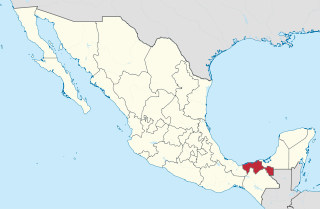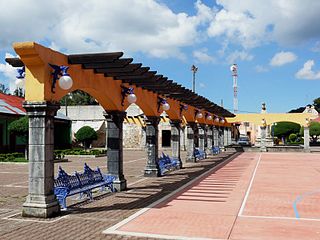
Yucatán, officially the Estado Libre y Soberano de Yucatán, is one of the 31 states which, along with Mexico City, constitute the 32 federal entities of Mexico. It comprises 106 separate municipalities, and its capital city is Mérida.

Tabasco, officially the Free and Sovereign State of Tabasco, is one of the 32 Federal Entities of the United Mexican States. It is divided into 17 municipalities and its capital city is Villahermosa.

Adolfo López Mateos was a Mexican politician who served as President of Mexico from 1958 to 1964. Previously, he served as Secretary of Labor and Social Welfare from 1952 to 1957 and a Senator from the State of Mexico from 1946 to 1952.

The Mexican Institute of Social Security is a governmental organization that assists public health, pensions and social security in Mexico operating under the Secretariat of Health. It also forms an integral part of the Mexican healthcare system.

José Reyes Baeza Terrazas is a Mexican politician and lawyer. In 2004, he was elected Governor of Chihuahua as a member of the Institutional Revolutionary Party for the term ending in 2010. Prior to that, he was Chair of Law at the University of Chihuahua in Chihuahua. He then served as mayor of the city of Chihuahua from 1998 to 2001 and as a congressman in the federal Chamber of Deputies (Congress).

Healthcare in Mexico is a multifaceted system comprising public institutions overseen by government departments, private hospitals and clinics, and private physicians. It is distinguished by a unique amalgamation of coverage predominantly contingent upon individuals' employment statuses. Rooted in the Mexican constitution's principles, every Mexican citizen is entitled to cost-free access to healthcare and medication. This constitutional mandate is translated into reality through the auspices of the "Institute of Health for Well-being," abbreviated as INSABI.

Omitlán de Juárez is a town and one of the 84 municipalities of Hidalgo, in central-eastern Mexico. The municipality covers an area of 110.5 km².
Mexico reformed its pension system in 1997, transforming it from a pay as you go (PAYG), defined benefit (DB) scheme to a fully funded, private and mandatory defined contribution (DC) scheme. The reform was modeled after the pension reforms in Chile in the early 1980s, and was a result of recommendations from the World Bank. On December 10, 2020, the Mexican pension system would again undergo a major reform.

Enrique del Moral Dominguez was a Mexican architect and an exponent of the functionalism movement, a modernist group that included Mexican artists and architects such as José Villagrán Garcia, Carlos Obregón Santacilia, Juan O'Gorman, Eugenio Peschard, Juan Legarreta, Carlos Tarditti, Enrique de la Mora and Enrique Yanez. The movement developed from innovative concepts presented by Frank Lloyd Wright, Le Corbusier, Mies van der Rohe and the Bauhaus school as well as Die Stijl, and remodeled the profile of cosmopolitan Mexico City and other cities in the 1930s.

Miguel Ángel Navarro Quintero is a Mexican physician and politician affiliated with the National Regeneration Movement (Morena). He served as a senator in the LXIV Legislature of the Mexican Congress from the state of Nayarit, his second term as senator after being elected to the LVIII and LIX Legislatures (2000–2006). He was also a federal deputy in the LVII and LX Legislatures and a two-time gubernatorial candidate in Nayarit. He is the current Governor of Nayarit.
Events in the year 1959 in Mexico.
Charbel Jorge Estefan Chidiac is a Mexican politician from the Institutional Revolutionary Party. He currently represents the XIV Federal Electoral District of Puebla, centered on Izúcar de Matamoros, as a federal deputy in the LXIII Legislature of the Mexican Congress.
The Guatemalan Institute of Social Security is the branch of the Guatemalan Ministry of Work and Social Provision that provides Hospital and Clinical services; pensions and income protection benefits, and employment counseling for salaried employees in Guatemala.
This article lists events occurring in Mexico during 2020. 2020 is the "Year of Leona Vicario, Benemérita (Praiseworthy) Mother of the Fatherland". The article also lists the most important political leaders during the year at both federal and state levels and will include a brief year-end summary of major social and economic issues.

The Ministry of Inclusion, Social Security and Migration is a department of the government of Spain responsible for planning and carrying out the government policy on Social Security, foreigners, immigration and emigration.

The COVID-19 pandemic in Mexico is part of the ongoing worldwide pandemic of coronavirus disease 2019 caused by severe acute respiratory syndrome coronavirus 2.
The Institute of Health for Welfare was a government agency of Mexico that provided medical services to those people who were not covered by the Mexican Social Security Institute (IMSS) or the Institute for Social Security and Services for State Workers (ISSSTE). It was established in 2020 and replaced Seguro Popular, the previous health insurance scheme which had been created in 2003. The director of INSABI was Juan Antonio Ferrer Aguilar. On April 25, 2023, the Chamber of Deputies approved its dissolution with 267 votes in favor, 222 against, and 1 abstention due to numerous supply and logistical issues in the health sector. As a result, the INSABI will be able to merge with the IMSS-Bienestar, and to take over its responsibilities; and offer healthcare to those who do not currently have access to public health services.
Enrique Yáñez was a Mexican architect. He was a theorist of functionalist architecture, and specialized in Mexican hospital architecture.












